The M2 Heavy Machine gun might certainly be old but it can get the job done in any sort of combat situation. And, even in some strange instances, can be used as a sniper-style weapon: Developed as the “big brother” to the Browning M1919 .30 caliber machine gun, the .50 caliber M2 was introduced in 1933 and nearly 90 years later it is still in service around the world
The M2 “Ma Deuce” remains the primary heavy machine gun throughout NATO and has been in conflicts around the world. Weighing in at more than 127 pounds with tripod and T&E (Traverse and Elevation Mechanism), the M2 is truly a “heavy machine gun” in every sense of the word.
But with a muzzle velocity of 2,810 feet per second and an effective range of 2,000 yards and a maximum firing range of 8,100 yards (7,400 meters) it can reach targets like almost no other machine gun on the planet.
A Strange Transformation
One of the lesser-known uses of the .50 caliber M2 is a long-range sniper rifle. It was during the Korean War that soldiers were first issued the M2 with special scopes, but it was during the Vietnam War that U.S. Marine Corps sniper Carlos Hathcock II achieved notoriety for one of the longest shots in U.S. military history.
Hathcock generally used a Winchester Model 70, chambered in .30-06 and with a standard 8-power Unertl scope. He managed to achieve an astounding kill record of 93 – including an impressive shot through an enemy sniper’s scope, but it was with the M2 that he was able to take out a Vietcong soldier pushing a bicycle loaded with ammunition at more than 2,500 yards.
When the record was finally broken in 2002 by a Canadian sniper it was with a purpose-built and highly-accurate sniper rifle, not a modified machine gun. Moreover, the 2002 shot used purpose-built .50 caliber ammunition, while Hathcock reported fired the basic M2 belt-fed ammunition.
Clearly, Hathcock’s achievement impressed at least one member of the British Army’s elite 22 Special Air Service (SAS), who decided to try to replicate the shot using – yes, another M2 Browning heavy machine gun. The SAS soldier did have a few advantages – namely that his machine gun was mounted to a turret on the side of his unit’s patrol vehicle. He also had an optical sight made for the machine gun.
During a patrol in Afghanistan, the SAS soldier locked the M2 to semi-automatic mode. Along with his spotter, the SAS operator waited 20 minutes, before depressing the gun’s butterfly trigger, and as the MilitaryTimes reported, “the rest, as they say, is history.” It took several seconds from the time the trigger was depressed for it to traverse the 1.5-mile distance before it hit an ISIS commander in the upper torso.
While other specialty sniper weapons may have been produced, at least two shooters have shown they can make the kill with an M2 machine gun.
Peter Suciu is a Michigan-based writer who has contributed to more than four dozen magazines, newspapers and websites. He regularly writes about military small arms, and is the author of several books on military headgear including A Gallery of Military Headdress, which is available on Amazon.com.

